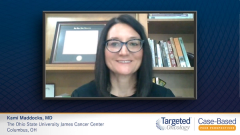
First-Line Therapy Options in Follicular Lymphoma
An expert hematologist discusses choosing first-line therapy options for patients with follicular lymphoma.
Episodes in this series

Kami Maddocks, MD: When a patient with follicular lymphoma [FL] presents, the first important thing to distinguish is if they’re in need of therapy or not. We know that treating FL just because it’s there does not prolong survival, and there are patients who present with asymptomatic low tumor burden disease who do not require treatment. For those patients who present with symptomatic disease, with B symptoms, with bulky disease, with cytopenias from their disease with end-organ damage or threatened end organ from their FL, they’re going to require treatment. The frontline treatment for FL is most often chemoimmunotherapy based.
There is a role for single agent rituximab in patients who are not candidates for more aggressive treatment with chemoimmunotherapy, because of age or multiple comorbidities, or in patients who have low tumor burden like symptomatic disease such as fatigue B symptoms, thus single agent rituximab can be used in these patients. Otherwise, we use chemoimmunotherapy. Most often we use rituximab in combination with bendamustine or with COP [cyclophosphamide, vincristine, prednisone] chemotherapy. There’s also approval of the frontline treatment using obinutuzumab, which is a different CD20 antibody than rituximab. Most frequently when I’m treating patients with FL for frontline therapy, I use a combination of bendamustine rituximab.
There have been 2 randomized trials comparing these, comparing bendamustine rituximab with CHOP [cyclophosphamide, doxorubicin (Adriamycin) vincristine (Oncovin) and prednisolone], or with CHOP and R-CVP [rituximab, cyclophosphamide, vincristine sulfate, and prednisone]. One trial showed that progression-free survival [PFS] was longer with bendamustine in combination with rituximab, although there was no overall survival [OS] difference, and both remain appropriate frontline treatments. I typically use bendamustine rituximab because it overall was better tolerated, so it doesn’t have the risk of cardiac toxicity, peripheral neuropathy, and it can be a little bit easier on counts with treatment. Also, patients don’t lose their hair with this treatment.
Regarding CHOP therapy, I typically use if there is concern for transformed disease. If there is transformed disease, I use this for sure, but sometimes patients will present with significant B symptoms very high LDH [lactate dehydrogenase] or high SUVs [standard uptake value] on PET [positron emission tomography] scan that you feel like is presentation of transformed disease, but you aren’t able to prove it, and I consider R [rituximab]-CHOP in these. We also know that in older patients, that there have been studies showing that there can be an increased risk of death, likely due to infectious toxicities from bendamustine, and so some people prefer to use R-CHOP in those patients. Obinutuzumab in combination with chemotherapy has been shown to prolong PFS over that with rituximab in frontline treatment for FL, however the follow up with this is short, and there was some increased infectious toxicity with this also seen. I typically reserve obinutuzumab for when patients relapse with their disease.
Transcript edited for clarity.
Case: A 74-Year-Old Man With Relapsed/Refractory Follicular Lymphoma
Initial presentation
- A 74-year-old man complains of a 6-month history of fatigue, occasional fevers, decreased appetite, fatigue, and an 8-lb weight loss
- PMH: unremarkable
- PE: palpable right axillary and cervical lymph nodes, palpable ~ 3 cm in both locations; spleen palpable 4.5 cm below left costal margin
Clinical Workup
- Labs: ANC 1.6 x 109/L, WBC 11.2 x 109/L, 44% lymphocytes, Hb 9.6 g/dL, plt 98 x 109/L, LDH 315 U/L, B2M 3.5 µg/mL; HBV negative
- Excisional biopsy of the axillary lymph node on IHC showed CD 20+, CD 3+, CD5+, CD 10+, BCL2+; follicular lymphoma grade 2
- Bone marrow biopsy showed paratrabecular lymphoid aggregates, 4% involvement
- Molecular genetics: t(14;18) (q32;q21)
- PET/CT showed enlargement of right axillary, cervical, and mediastinal lymphadenopathy (3.3 cm, 3.1, cm and 4.6 cm respectively)
- Ann Arbor Stage IV; ECOG 0
Treatment
- He was treated with R-CHOP for 6 cycles, achieved complete response and continued rituximab maintenance
- 24 months later he complained of increasing weight loss, fever and drenching sweats as well as more enduring fatigue and new onset itching; he was currently taking antibiotics for his 3rd bacterial infection in the past year
- Repeat PET/CT revealed progression of disease
- He was started on bendamustine + rituximab for 6 cycles and continued on rituximab maintenance
- Repeat lymph node biopsy grade 2 follicular lymphoma
- 12 months later he complained of continued weight loss, increased itching and worsening fatigue; recurrent infections continued
- He was started on idelalisib 150 mg PO BID








































